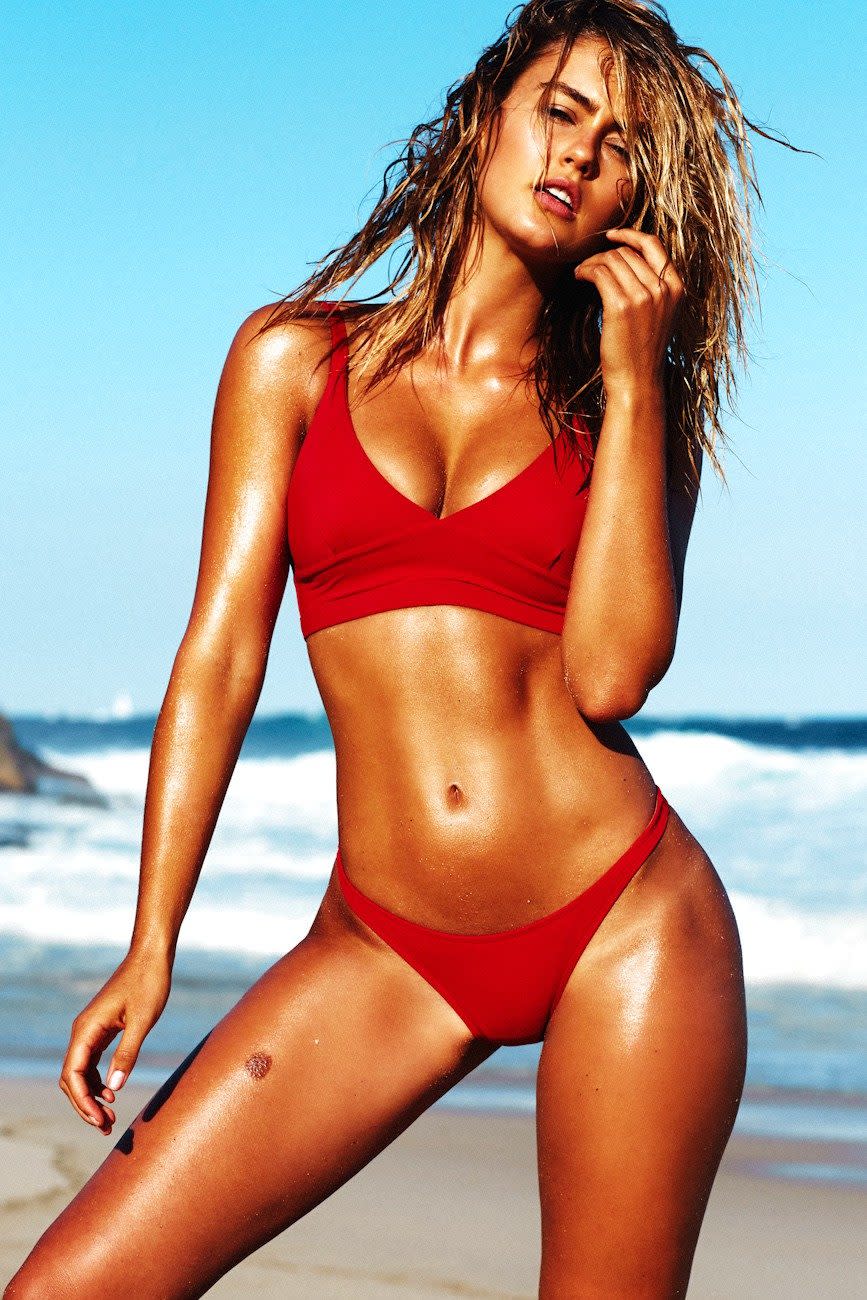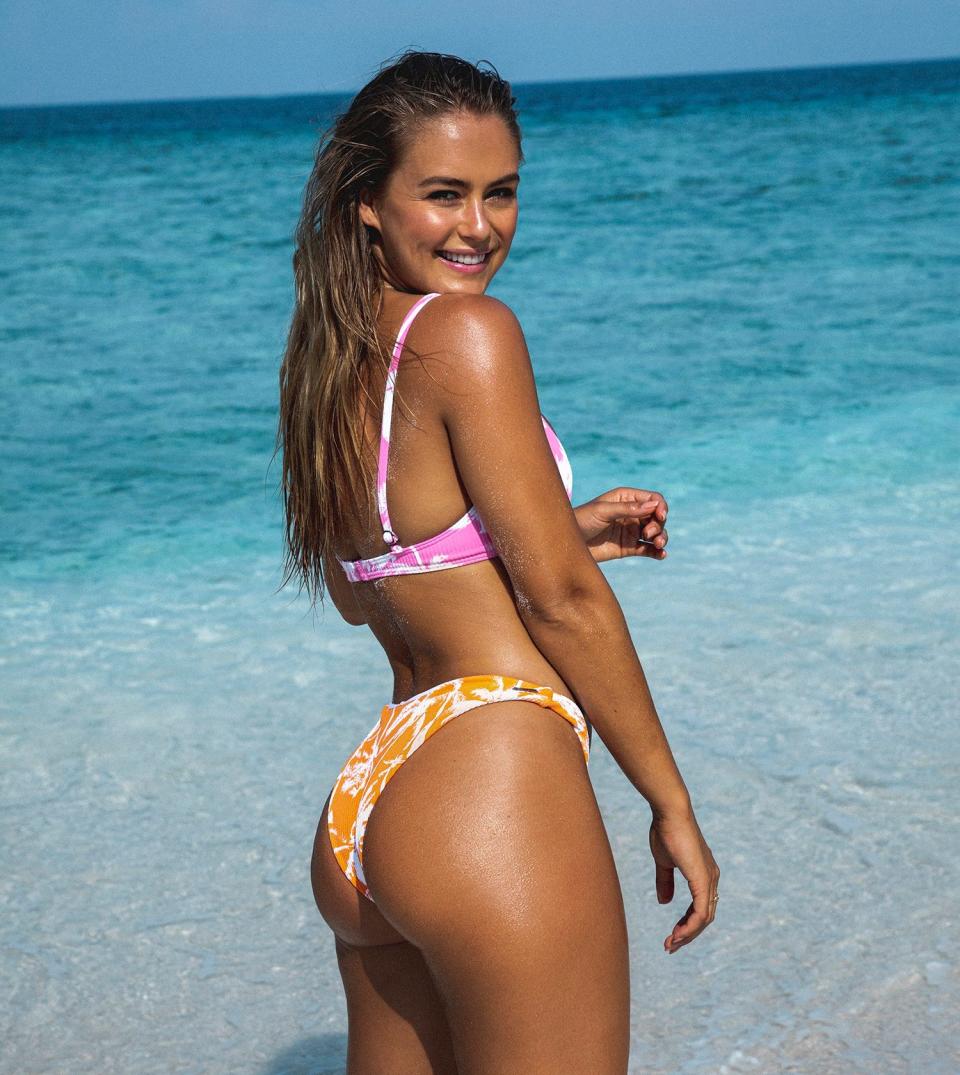‘I was a size 6 but I still felt too big when I was a model’

The modelling industry may seem glamorous but there’s a dark side to that world – it took me a long time to recover. Back in 2014, as a 20-year-old model in Australia, I moved from my homeland of Melbourne to New York, hoping to make it big, but soon my mental health began to spiral.
I felt lonely and lost, confused by the unhealthy advice my new model agency in New York was insisting on giving me, much of it downright dangerous – tips like “take up smoking to curb your hunger” or “eat an apple instead of lunch”. They even told me I had too much muscle and that I should try to lose some of it by avoiding strength training.
I was only a UK size six with size eight hips, but in my agency’s eyes, my hips were too big at 36 inches, which is crazy. They used to measure my hips, bust and waist twice a week and tell me I had to reach a size four-six – as small as my teenage body had been. My hips seemed to be the main issue. They told me I needed to get down to 34 inches to be a success as a model.

My agents made me believe certain food groups should be demonised and that I should avoid all the foods I’d grown up loving – carbs and sugar mainly. Anything from a packet and not fresh was banned.
I became extremely controlling over which food groups I would allow myself. I only had a green juice for breakfast and something small like a sushi roll for lunch, so at night I began to crave and binge on “forbidden” foods like pasta.
Living alone in my New York apartment, it was the first time I’d ever cooked meals for myself and as no one was watching, I began binge-eating all evening. I would go to Whole Foods supermarket, stock up, then go back home and make myself a gigantic dinner. As I’d restricted my eating so much in the day, I’d tell myself, “Well I can overdo it now, let’s fill up.”
I’d eat a huge meal, then serve myself a big second helping, grab some snacks like big spoonfuls of peanut butter straight from the jar and have a dessert too. I’d then reach the point where I was uncomfortably full and would make myself sick.
It was a horrible mindset because by the time I went to bed, I’d feel terrible about the amount I’d eaten and how I’d mistreated my body. I would talk to myself in a very negative way and fall asleep feeling depressed, thinking, “Why do I keep doing this? What’s wrong with me?”

I binged in private mostly, so I started trying to avoid being home alone, particularly at dinner time. I began staying at a friend’s house a few nights a week for company, but the next day I’d be home and the binge eating cycle would start again. He was a friend of my boyfriend Josh back home in Australia, and I never told him what was going on. I didn’t confide in anyone at the time, even Josh.
I did hint to another model, Laura (Henshaw), that I was struggling. We spent hours chatting to each other between castings, comparing notes on the pressures we were being put under. She ended up becoming a close friend and my future business partner.
You often can’t tell when someone has an eating disorder – they might look fine but have unhealthy habits like I did. It was as if I was trying to fight the intense pressure I was under by bingeing all evening.
As a young model, in my early twenties, I became obsessed with trying to be perfect, comparing my body, diet and exercise routine with those of everyone around me. I remember a pivotal moment when I met three high-profile Victoria’s Secret models that I’d always idolised. I was so starstruck when they walked in.

They were just getting ready for a workout class and I vividly recall them picking themselves apart in the mirror and sharing their insecurities about their bodies. It was an eye-opening moment for me, realising, “Hang on, these people, who in my mind are perfect, don’t think they’re perfect.” I started to wonder, “Is anyone ever just happy in their own skin?”
It was right before New York Fashion Week, a time when many models are even smaller than usual. Many eat nothing but smoothies in the two weeks before the shows. Others drink loads of water, then the day before the show won’t drink anything at all so their body is dehydrated and looks as small and lean as possible – a highly dangerous habit.
I’d grown up a confident girl and enjoyed being a child model, but after moving to New York my confidence was shot to pieces. Before I went out in the morning, I’d change my outfit 10 or 20 times trying to find clothes that made me look as skinny as possible. I even started buying clothes that were too big for me so I’d look thinner in them. I used to be comfortable in tight-fitting clothes, but now I never wore them.
As a model, I was often treated like an object. On one job when I was modelling a range of underwear and revealing clothing, when I asked the stylist where the bathroom was so I could change, she told me it was a “long walk away” and that “most of the girls just change here in the studio. Are you OK with that?”

I went along with it as I wanted to impress this client. I’d heard he could be a good regular and that’s every model’s goal to get those “bread and butter” jobs providing a regular income. But just as I started changing the client suddenly appeared – an older man.
He came over and said, “Hang on, before you put that on, let me look at you. I need to see what your body type is so I know what will look best on you from the collection.” I was made to stand there in a nude bra and nude G-string – nearly naked – and slowly turn around, so he could inspect me and pick out what I’d wear. It made me feel violated and the stylist didn’t step in to try to stop him.
I wasn’t sure what was “normal” and acceptable from a client, as I was still new to the scene in New York, so I asked other models and my agency afterwards and was told this wasn’t normal and he’d been flagged for doing this to other girls before.
As a new model, it’s usual to do “test shoots” with up-and-coming photographers for free. On one of them I was asked to wear a high-cut dress and while I was standing there, the photographer suddenly asked me to take my underwear off. I questioned why he couldn’t airbrush my underwear out, but he insisted it would be “easier” if I just took it off.
I’d seen lots of photographers had portfolios of near-nude shoots, so I reasoned as other girls had done it, maybe it was the norm and I should too. He did look away when I moved into different positions but I very felt uncomfortable.

I did have beautiful, tasteful nude shoots with some photographers I felt at ease with, which I don’t regret, but this felt different as I was asked to remove my underwear in front of him. Agreeing to be naked is all about the context.
I worked as a model full-time for seven years. During my career, I got to travel the world and shoot global campaigns for clients such as Adidas, Billabong and Bondi Sands.
After eight months in the US, I joined a lovely new agency in New York, who told me they thought I was great exactly as I was. I got them to agree up front that they wouldn’t pressurise me to lose any weight. But two months later, I decided to move back to Australia to be with my friends and family, my boyfriend Josh and my Australian agency, who celebrated me for being me.
I eventually quit being a full-time model in 2018 and now just do the occasional modelling job – around five a year – only for clients who are aligned with my personal values and celebrate body diversity.
That same year I co-founded the holistic health and wellness app Kic, where I’m now chief community officer with my friend Laura who is CEO. The app has been downloaded over 700,000 times globally. It began as a recipe e-book and grew from our experiences of battling with our body image. Our aim now is to put a stop to harmful mentalities and toxic trends disguised as wellness. There’s no calorie counting and no body transformation images on our app.

I don’t agree with “before and after” weight loss transformation photos being posted on social media because they imply there’s something wrong with the body in the “before” picture.
We want to change the way women of all ages feel about themselves and their bodies. We have an active community both in Australia and the UK who message each other with encouragement, we run “in person” exercise events and have lots of fun workout videos on the app and we’re aiming to increase the number of events across the UK.
My body confidence is now the best it’s ever been, especially since becoming a mum. I have a healthy mindset and am realistic about exercise. My husband Josh is a stay-at-home dad and we have a two-year-old son, Harvey. I do a weekly strength training session in the gym, and “incidental exercise” like trying to walk as much as possible, or I’ll snatch a 10-minute pilates workout at home, if that’s all I can fit in around running a business and being a mum. I don’t want to miss out on my time with Harvey.
My message to other women? If you can move your body, that’s to be celebrated. Don’t try to be an athlete; working out six times a week is unrealistic, just be grateful for the body you have and fuel it with whatever food makes you happy.
Kic is available to download on the App Store and via Google Play. Find out here how to start your free seven-day trial. You can follow Steph Claire Smith on Instagram. If you or someone else needs help with an eating disorder, contact the UK’s eating disorder charity Beat for support.


